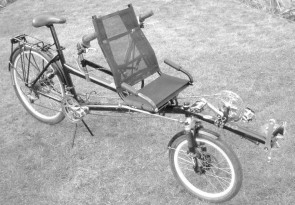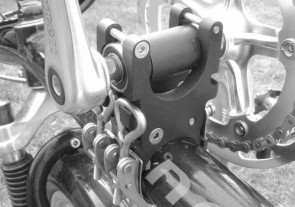 We always do our best to concentrate on the practical aspects of cycling. Can you ride it to work (and carry it into the building)? Can you take the children to school on it (or in it)? Can you take it on holiday? Does it fit in a car, train, bus or plane? As a consequence, we tend to come back again and again to the same solutions, because certain bikes, trailers and other bits and pieces are so damn practical. It also means we ignore all manner of wacky and wonderful things – many of them recumbents. As a general rule, if it won’t fit in our bike shed, it’s unlikely to fit in yours, so we leave it to the more – how shall we put it – esoteric publications. You know the ones.
We always do our best to concentrate on the practical aspects of cycling. Can you ride it to work (and carry it into the building)? Can you take the children to school on it (or in it)? Can you take it on holiday? Does it fit in a car, train, bus or plane? As a consequence, we tend to come back again and again to the same solutions, because certain bikes, trailers and other bits and pieces are so damn practical. It also means we ignore all manner of wacky and wonderful things – many of them recumbents. As a general rule, if it won’t fit in our bike shed, it’s unlikely to fit in yours, so we leave it to the more – how shall we put it – esoteric publications. You know the ones.
…It barely fits in the shed, it weighs 25.4kg and it’s complicated, but it’s dead cool…
But once in a while, we like to do something a bit silly, and that’s why we requested a Hase Pino in child-carrier form.Yes, it barely fits in the shed, it weighs 25.4kg (56lb) and it’s complicated, but in school gate terms, it’s seriously dead cool. If we’d turned up with a bright red Ferrari, we wouldn’t have generated a greater buzz of excitement outside Castle Cary primary.Well, not much anyway.
Butcher’s Bike
The Pino is laid out rather like a traditional ‘butcher’s bike’ – a big 26-inch wheel at the back and a small 20-inch one under the load platform at the front. But in this case the load is a recumbent adult, or with the right adaptor, a child.
 Quite why anyone would choose to travel like this is a bit of a head scratcher.There certainly are a few key advantages over an upright tandem or trailer bike. Firstly, you can keep an eye on the child, which makes these machines popular for carrying disabled children. Secondly, the laid-back passenger probably helps to smooth the flow of air round the machine (but with frontal area similar to a conventional upright bike, don’t expect to break too many speed records).The disadvantages are that it’s an expensive beast (£2,315), and a cumbersome one, although in recumbent tandem terms, the wheelbase of 1.4 metres and overall length of around 2.4 metres (two metres in child-carrier form) are not particularly long.
Quite why anyone would choose to travel like this is a bit of a head scratcher.There certainly are a few key advantages over an upright tandem or trailer bike. Firstly, you can keep an eye on the child, which makes these machines popular for carrying disabled children. Secondly, the laid-back passenger probably helps to smooth the flow of air round the machine (but with frontal area similar to a conventional upright bike, don’t expect to break too many speed records).The disadvantages are that it’s an expensive beast (£2,315), and a cumbersome one, although in recumbent tandem terms, the wheelbase of 1.4 metres and overall length of around 2.4 metres (two metres in child-carrier form) are not particularly long.
The child-adaptor is very neat.Whip off the telescopic section of the adult boom (you don’t have to, but this reduces the length and weight of the machine), clamp the adaptor to the remaining boom and shorten the chain to suit.The child-adaptor has 110mm cranks, and together with the laid back position, enabled our five-year-old to pedal with real efficiency.
One way or another, the Pino will carry anyone from a child of four up to a full-size adult, but the conversion is a slow and rather fiddly process. Had you been – for instance – roaring around the country lanes on Sunday afternoon with the missus on board, you’d need 30 minutes on Monday morning to rejig it all for the school run.
Riding
We were warned that the Pino takes a bit of getting used to, which is true, but most people develop confidence within a kilometre or so.The only real problem is steering lock, which can be a bit limited with certain seat/handlebar positions, so it’s essential to check that you have sufficient lock before riding off.The need for plenty of steering movement becomes clear on the first wobbly corner/steep ascent, because the longish wheel base, and slightly odd geometry force you to do a lot of juggling with the controls to stay upright.
Different riders, and slight movement of the front seat or handlebars will affect the amount of steering available. If you’re the sort of person who checks your dipstick each morning, you’ll give the steering lock a brief inspection before setting off. If not, you may find yourself checking it in the middle of the first corner, as we generally did. A recipe for disaster.
Recumbent aficionados are a vociferous lot, but this sort of monster is inarguably cumbersome compared to your average 16-inch folder.That said, we did soon get the hang of it, but only by removing the toe-clips – at low speed and in traffic, you do not need a delay in getting your feet down.With practice, the turning circle is a little under 4.5 metres, which is jolly good, but as with the Space Shuttle, the speed and angle of re- entry must be be gauged with care or you’ll be off (again).
On the open road, the outfit nips along very well.Tyres are the well-respected (and by some, hero worshipped) Continental Top Touring. Energy consumption at higher speed felt somewhere between that of a conventional tandem and a recumbent, much as you might expect considering the riding position.The Shimano Deore derailleur gives 24 gears, and a range from 20 inches to 114 inches, which covers most eventualities. Actually, the low granny gear is less useful than it sounds, because on a steep slippery climb, the rear wheel soon loses traction, the steering flails about and it’s all over.

With the adult boom fitted (but not connected), the overall length becomes clear. Steering from behind the passenger takes a little getting used to.
Unusually, there’s a freewheel in the middle chainring, so the front-seated stoker can stop pedalling if they want.The good news is that the pilot can both see and hear this and issue orders accordingly – on the Pino, there is no escape from authority.
Equipment

The neat child adaptor puts a pair of 110mm cranks just where they’re needed
Brakes are Magura hydraulic discs front and rear, which is generally considered to be a state-of- the-art arrangement. Recumbents should do well in terms of absolute braking performance, because on a traditional upright bike you’ll be flying over the handlebars long before a really good braking system runs out of steam. Riding the Pino ‘one-up’, the problem is a little different, because the rider is too high, and too far back to get enough weight over the front wheel to do a really good stop.The rear brake achieves a creditable 0.4G, but the front wheel tends to lock suddenly and unpredictably at anything between 0.42G and 0.5G, depending on the road surface – loose material can be fatal. Obviously, things are better with a load on the front. Carrying a 14kg dead weight (as opposed to a wriggling one), the front brake hits 0.65G, but results are, again, very much dependent on the surface.With both wheels locked (quite exciting), we saw 0.67G a couple of times. An adult on the front would help, but bearing in mind the sudden and unpredictable nature of the front wheel lock-up, we were unwilling to try.
Compared to an upright bike, stability under braking is one of those swings and roundabouts situations: in extremis, the bike would be unlikely to pitch you over the handlebars (although it might, with a light captain and a heavy stoker), but more likely to lock the front wheel and deposit you sideways onto the road.
Being German, the Pino comes equipped for riding in ‘real’ conditions, with mudguards, a bell and a good dynamo lighting system:Toplight Standlicht on the front and Busch & Müller Lumotech at the rear. A word of warning – the front light is fixed to the adult boom, so regular child-carriers would need an alternative arrangement.
There’s a conventional rear rack, and a large box of groceries can be strapped into the front seat, so the Pino could handle a fairly bulky supermarket shop if required.
Conclusion
Being terribly mean, we’d find the price a bit scary, and lacking the space, we’d find a Pino a nuisance day-to-day. On the other hand, children love it, and we’d guess that even a teenager might agree to a Pino school run.We’ll let you know. For the suitably extrovert, this machine could solve all sorts of transport problems.
Specification
Hase Pino £2,315. Weight 25.4kg (56lb). Wheelbase 143.5cm. Length (c/w adult boom) 2.4m Gears Shimano Deore 3 x 9spd . Gear Ratios 20” – 114” . Manufacturer Hase Spezialräder web www.hasebikes.com mail info@hasebikes.com tel +49 2309 782582 fax +49 2309 782586
A to B 47 – April 2005
![]()
